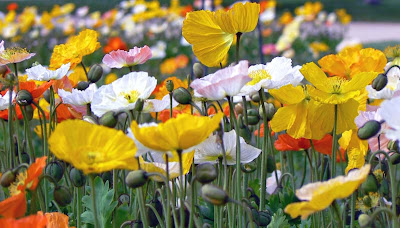The moment arrived, albeit a bit slowly. The line to pay to get into the natural history museum was not long, but all the people ahead of me took their sweet time. They all had special questions, special requests, or special circumstances. Talk, talk, talk.
 La Grande Galerie de l'Evolution, seen from the main entry to the Jardin des Plantes.
La Grande Galerie de l'Evolution, seen from the main entry to the Jardin des Plantes.
There were two registers for paying the entry fee*, but everyone made one line. Then all of a sudden, the people at the end of the line made a second line, effectively cutting those of us in front off. Cutting in line in France is an art form. If you dare to cut, it's your right to do so. As far as queuing goes, it's every person for himself. And while everyone will huff and puff, no one will actually do anything about it. This goes for grocery stores, train stations, you name it.
 The main hall seen from the upper levels.
The main hall seen from the upper levels.
Finally, it was my turn to pay. I said, "One, please." Bam, bam, I had my ticket and was off. Why do my transactions always take two seconds, while everyone else's take five minutes? No matter. Through the turnstile I went. I had seen a report about the museum's renovation on t.v., so I had a vague idea of what I was going to see.
 The parade of large animals is an impressive sight.
The parade of large animals is an impressive sight.
I was incredibly impressed with this place. I love natural history museums, science and technology museums, and the like. I'm as intrigued by the buildings that house these institutions as I am by the exhibits, and this building did not disappoint.
As I entered the main hall, I was met head on by a virtual stampede of large animals: elephant, giraffe, wildebeest, zebra, tiger, and rhinoceros, just to name a few. Surrounding them were smaller groupings of smaller animals, and cases of mounted butterflies and insects. You can walk all around, seeing the animals from all angles, but I think touching them, while entirely possible, is not allowed.
 A blue-faced monkey. I don't remember the exact name of the species.
A blue-faced monkey. I don't remember the exact name of the species.
I made my way to the upper levels so that I could get a good photo of this spectacle. The upper levels wrap around the main hall. One side is where all the access is (stairs, elevators) and the remaining three sides are filled with exhibits. My quick climb up was rewarded with having the upper levels virtually to myself.
There's a separate hall of extinct and endangered species; I was the only human in there. There were also exhibits on the beginnings of life on earth, a little about how river habitats evolve, reproduction, plant and fungus evolution, birds, reptiles, monkeys, just about everything.
 Here they come!
Here they come!
Down below the main level were the exhibits related to fish and marine species. There was a special whale exhibit in the basement, but that seemed geared more toward kids and was less interesting to me. The light was very dim throughout, and flash photography was not allowed, so many of my photos came out blurry. But some worked, and these are they. Next time, tripod.
I could have spent much more time there, but I also wanted to wander a bit outside in the gardens before meeting my lunch date. I got a good taste of the museum and will definitely go back some day.
More tomorrow...
*The museum pass didn't cover this museum, so I had to pay.
 Callie sitting in the shade of the umbrella.
Callie sitting in the shade of the umbrella.
























































